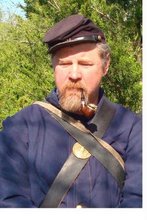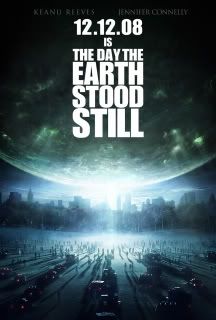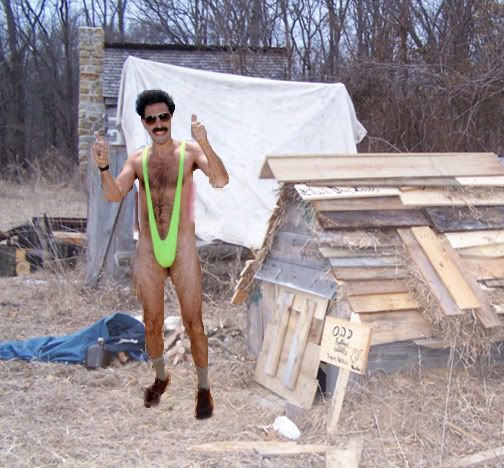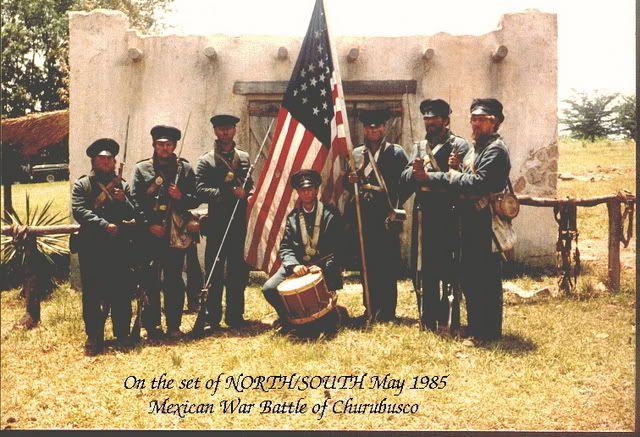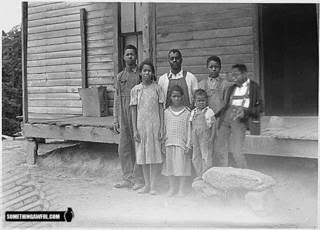Beginning in 1983, and only lasting a couple of years, a few of us brave souls ventured into unknown territory by getting involved with reenacting the Mexican War 1846-47. Rather than do battle with real Mexicans (not PC), we instead did living history at such places as Fort Scott, KS, Arrow Rock, and Fort Osage (Sibley, MO). In May of 1985 a bunch of us journeyed to Natchez, MS to take part in a made for TV movie. Here is that story and it comes from Chin Music From a Greyhound, Volume One (available at Amazon.com).
******************************************
Over the winter, word came to us of the made for TV movie NORTH AND SOUTH which would be filmed near Natchez, Mississippi during the month of May 1985. Reenactors were being called to participate for a period of five days for the filming of the Mexican War Battle of Churabusco. I believe the infantry was offered $50/day with slightly more given to those who were bringing a cannon. (NORTH AND SOUTH was adapted from the John Jakes bestseller of two men, one from the North and one from the South, who became friends at West Point, went to Mexico and later on opposite sides during the Civil War. For the most part the book was a soap opera; it chronicled the pain, sorrow, and lust of family members who either jumped from one bed to the next or hatched devious plots of revenge or both.
I took one week's vacation from work with the plan that I would drive down with John Maki in my Mitsubishi. Gregg Higginbotham could not make the trip, so his gear was loaned to a Marine Corp buddy of Frank Kirtley's. At the last minute I learned that Charlie Pautler needed a ride so John and I had to make room for him. There was only room in the front cab of my Mitsubishi for two as the gearshift was right in the middle of the floor. A pallet of blankets was laid out in the bed of the truck with all the gear pushed to one side. We had a couple of John Maki wooden boxes with all our stuff including tents, plus we had a cooler that had snacks and suds. I still had an aluminum cover bolted on the back on my truck and it had two side windows, which could be opened for ventilation. We took turns between the three of us who would lay in the back.
Our route of travel was similar to one we took when we went to Champion's Hill some years back. I think we left on Saturday morning and arrived in Vicksburg about 12 hours later. This was our third visit to Vicksburg in 5 years and of course we had to take the driving tour. We ran into Skip Merriman and Jerry Vest while at Vicksburg so we conspired to travel the rest of the way to Natchez together. The five of us spent one night in a cheap motel, we had an authentic Cajun dinner somewhere along the way. I had a plate of fried frog's legs, and I think someone had a bowl of gumbo. We also stopped at a roadside fish market and Jerry Vest bought about 2 lbs. of boiled crawdads. I was offered, but I was hesitant to eat any of the monsters. I watched Jerry Vest and John Maki pop away a few with no side effects, so I said what the hell. The only part that is eatable is the ass end. These suckers had been boiled and then dipped in some kind of red pepper sauce or some shit. My lips and tongue felt as if I'd been French kissing a hot iron, but I developed a weird affection for the spicy crustacean's anyway.
To make a long story short, we finally arrived at the site where the movie was being made, some out of the way countryside near Natchez. We signed in, located our campsite, and began setting up the A tents. Frank Kirtley and his buddy Mike Neitze rolled in about the same time the rest of us did. Among the few faces we recognized among the reenactors was Joe Covais' Illinois volunteer's, Kyle McGonigle's Iowans, and Holmes Brigade pard Ken McElhaney who was throwing in with Dan Lawrence's artillery bunch from Texas. All the US Regular's were required to camp together, so we reluctantly threw our lot in with Kyle's Iowan's. Maki had piled all the boxes in the tent with him, so Charlie Pautler was forced to share an A tent with me. I think we spent about 5 days and 4 nights on this site and it was during this time that I got to know Charlie. We had been doing Mex War for about a year, but beyond rubbing elbows at these events, the only thing I knew about him was that he was the son of Missouri Confederate Brigade commander Don Pautler. After a long day getting blowed up on the hot, dirty movie set, we'd drag our tired ass bodies the quarter mile back to our tents, eat, then if not quite tired enough to fall asleep, we'd sit around, drink a little popskull and tell stories. Charlie and I concocted a ridiculous scheme to market a Civil War paper doll collection featuring Jefferson Davis-"anatomically correct." In our mind's eye we also wrote long Civil War narrative's featuring soldier's who were just "sittin' around packin' fudge, when all a-sudden, the yankee's showed up!"
Hollywood built an outdoor shower for us, but Charlie, Maki, and I decided to do without. Even as we got grimier as each day went by, and the bugs began to nest in our orifices, we went without even a whore's bath just to see who could go the longest. Finally on like the fourth day, Charlie went into town with some pards to go swimming at a hotel. One night, Hollywood handed out steaks and beer from a pickup truck that came through the camp. Like a herd of locusts, the reenactors descended on the treasure from the stars. Maki instructed us to fill our pockets with as much as beer and steaks as we could, even down our pants if need be. It looked like a bunch of overweight women elbowing each other just to get a pair of shoes during the bluelight special at the local retail store. Kyle McGonigle and his Iowans just sort of moseyed on over; they didn't want to get trampled on and they were in the belief that we'd leave something for them, beings we were all gentlemen. HA! When the smoke cleared there wasn't enough to feed a flea and so Kyle and his boys went back to camp with their heads hung low and nibbled on Slim Jims for supper. Meanwhile, us pukes from Missouri were laughing in the darkness and feasting on steaks and beer until the juice's ran down our chins.
One evening, some of the Illinois boys announced they were going into Natchez where there was a whorehouse. It seems Nellie's was a legalized, state run brothel and drew as many tourist to its door step as it did horny bastards. Beside's the usual merchandise, Nellie also sold T-shirt's. About a dozen of us crammed into a pickup with a large camper shell on top-the kind you can stand up in. We briefly got lost trying to find the right street, but then we were there-at an old ranch style house with many high-yellow colored gals running around in their flimsy's. Some of the sucker boys went to get his brass polished, but the rest of us were content to sit in the parlor with an old black granny who was the Madam. She took a shine to Maki and tried to romance him, but he told her we only came for the T-shirt's. To be honest the place didn't look all that clean for a tourist attraction and the T-shirts we washed before we put on.

Now then, it's finally time for me to get around to talking about what the movie set looked like and our experiences on it. Well, it was located about a quarter mile up a hill from our campsite. In the morning, we marched out as a battalion to breakfast. Hollywood fed us breakfast from a large circus tent. The spread would have made King Henry the VIII jealous. We had cold and hot cereals, fresh fruit, donuts, muffins and juice of all kinds. Eggs, bacon, ham, sausage, biscuits and gravy, etc. from a buffet. Just as the military has done throughout the centuries, Hollywood also travels on its stomach. The caterer's to the stars go "whole hog" when it comes to feeding people on a movie set. About mid-day, Hollywood would stop for lunch; the crew ate first because they had to hurry back to the set to get their props and equipment ready for the next shot. Everything and anything that could be killed, boiled, baked, and/or fried was consumed at lunchtime. Supper was the only meal not provided to the reenactor's while on the NORTH AND SOUTH movie set, so some guys would go into Natchez to eat or cook the rations brought from home.
"The first time the crew and cast ate lunch, the crew got there just before we did," remembers Ken McElhaney whom I am proud to include in these NORTH/SOUTH observations,"they were daintily using the right plastic utensils to put the right amount of food in the proper areas on their styrofoam trays when Maki and I hit the buffet line. John was covered in dirt and he grabbed whatever utensil was handy and dumped food on the tray, mixing potato salad with jello. When some of the jello was getting away from him, he just used his filthy hand and grabbed it, then slammed it back onto his tray. Next to me was some of the film crew with jaws agape and whispering under their breaths, "oh..my...GOD!". I didn't have time to apologize for John's behavior since I was slammin down food on my tray, too."
Once arriving on the set, we were in the midst of a small village of one floor adobe huts. However, Hollywood only built the front wall of the buildings-that which faced the camera. There were no back or sides what-so-ever with 2 x 4 lumber and sandbags holding it in place for support. The ground was very dry here with little or no vegetation, so Hollywood planted a number of small trees and weeds around the village and even spray painted the ground green to resemble grass. About fifty yards from the "village", a Stone Bridge had been built over a stream with even more "trees and weeds" planted along its bank. On the other side of the bridge and about another fifty yards was a trench line with about 6 artillery pieces lined up wheel to wheel. This was where the Mexican Army would be during the battle sequence. From a distance Hollywood hoped television viewers would get the illusion that this was a small Mexican village caught during a major battle. Broken artillery pieces, lost equipment, sandbags scattered about and a fallen tree were also added to the set to spice up the look of the battlefield. Over a dozen ground charges were set to go off at random intervals during filming, with several of those placed in the water. The ground charges consisted of placing large metal pans, which looked like Chinese woks, a couple inches below the ground and loading them with black powder, peat moss, potting soil, and pieces of corkboard. The charge's planted in the stream were obviously very different than those in the ground and had to be rigged to vomit water 50 feet straight up into the air.
What the reenactor's were called to do while on the set was basically "run around like chickens with their heads cut off" while explosions went off at our very feet. We would not to fire one shot during our entire time on the set. Our uniforms and faces were dusted with a variety of stains upon arrival on the set (we had to look campaign hardened). When the director called action, we either ran around in a panic or lay flat on the ground as "dead soldiers" while being peppered with potting soil and hot hunks of corkboard from the very close ground explosions. In the meantime, the principal actors were required to carry along a dialogue during this hellish confusion.

Patrick Swayze (pre-Dirty Dancing) and James Read were the two West Point chums-one from the South, the other from the North respectively. In their roles of Lieutenant's Main and Hazard, the script required them to shout brave encouragement's to their men, fire pistols, and sometimes perform acrobatic stunts by bouncing off logs or fencing with Mexican's. It was a combination of Errol Flynn meets Monty Python. At one point the two chums were confronted by an old nemesis from the past-an evil man whom the two had conspired against and gotten kicked out of West Point. Using political influence, this man had rejoined the US Army with the rank of Captain, and now he was ordering Lts. Main and Hazard to take some men on a suicide mission..."for a report of enemy strength at the bridge. Now move before I shoot you where you stand...for disobeying a direct order...from a SOUPerior officer!" I recall this exchange vividly, because the actor was delivering his lines from atop a 7-foot stepladder. The horse he rode in on was skittish and the actor could not control him too good. The reenactors were about ten yards from this scene and it had to be reshot several times before everyone got their lines perfect.
Old pard Ken McElhaney has another perspective of this scene and I gladly share that with the reader as well. "If I remember correctly, that second rate, Frank Sinatra wannabe actor who couldn't get the 'I heard you two were here...' speech right took, I believe, thirty six takes. You'll certainly want to confirm this with the others, but I do remember the script girl (or as I called her, the 'Crew Lush') barking out each take up to thirty six. Also, old baldie, or the leader of the 7th Illinois Cav, whose name escapes me at the moment ( Karl Luthin), told me that that particular horse our fave actor was sitting on was sixteen years old and had been in battles for the past ten years or so. Anyway, baldie blamed the actor for holding his pistolie next to the horse's head instead of over it. The horse would see the pistol and try to get out of the way, the actor would try to fight him back and the director yelled cut."
Between takes, the actors would catnap in folding chairs in the shade, go over their lines, rehearse a stunt, or play "hacky sack" with several members of the crew (that's when you kick a beanbag back and forth using only the side of your foot). Ken McElhaney recalls that "Pat Swayze wanted to take a piss break right before a take, the pink-panted director (or 'Popeye', as I called him because of his crappy sailor-ish hat) told Pat to hold it because he didn't want him going all the way back to his trailer. Pat, in the only cool move I ever saw him make, took three steps into the woods and let it go right in front of everyone."
It was during these breaks, that an actor would have a crew member spray a cool mist of water on his face (artificial perspiration we called it) or the crew member was sent to fetch a diet soft drink. The scene I observed was played out a few yards from me as one of these surfer-looking dud's with sunglasses whispered in his walkie-talkie for someone to bring up a cold DIET SPRITE for Mr. Swayze. We called these Hollywood assistant's "piss boys", after characters from the classic Mel Brooks movie HISTORY OF THE WORLD PART 1. Another "piss boy" brought back a couple cases of TWINKIES, compliments of actor James Read, which were handed out to the reenactors. Who the hell eats TWINKIES in 100 degree temperature? We did! It was like eating a SEALY mattress with sugar on it and we had to drink gallons of water afterwards just to reopen our throats.
The final scene involved the blowing of the bridge, with Patrick Swayze getting caught in the blast. We were told the crew was going to wrap up after this and prepare to go home. We were disappointed. We'd wanted them to film us actually fighting, not running like scared little girls. Finally word came down to stand by for a final scene. We were going to get our wish. As we waited, actress Leslie Anne Downe came slinking over like a cat. She seemed a little light-headed and sappy (might have been the heat), but she smelled real good. And was very easy on the eyes! It seemed in the TV Movie she would play the love interest of Patrick Swayze. After some harmless flirtation, she was led away by her handlers to her trailer where I'm sure a Hollywood "piss boy" was there waiting to attend to her 'needs'.
We'd been in formation for nearly an hour and it was near dusk. Finally we were called out. The Hollywood camera's were loaded with a low-light film and the director signaled our action to begin. With a joyous shout, we lined up in line of battle, with bayonets leveled at an imaginary foe, and marched forward. Then a halt and we fired a volley, then pressed on till out of camera frame.
So the movie was over. We loaded all our stuff that night, pulled out and spent the night in a nearby motel. One of the first things all seven of us did after checking in was to find a sit down restaurant and ordered several pitchers of ice water. The next morning it was back to reality as we headed home and the daily grind stone of 9 to 5 drudgery.
************************************The End?

 Research has led us to learn that the 3rd Missouri wore a gray overshirt, a gray hat, carried a Model 1842 .69 caliber Springfield Rifle and wore white buff leather accoutrements. No one has seen any photographic evidence of this exact uniform; we only have the written word to go by.
Research has led us to learn that the 3rd Missouri wore a gray overshirt, a gray hat, carried a Model 1842 .69 caliber Springfield Rifle and wore white buff leather accoutrements. No one has seen any photographic evidence of this exact uniform; we only have the written word to go by.




